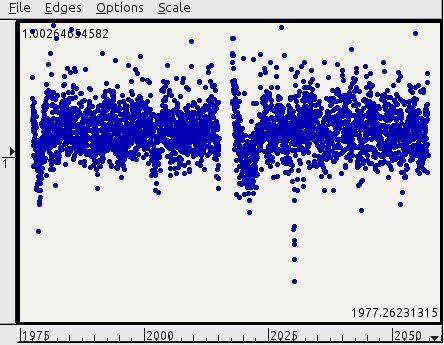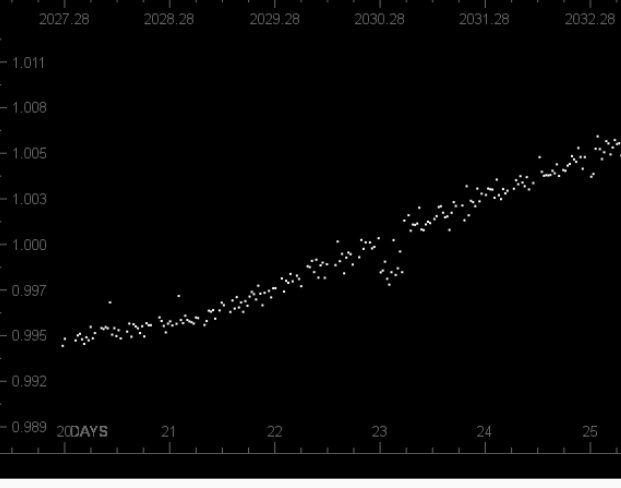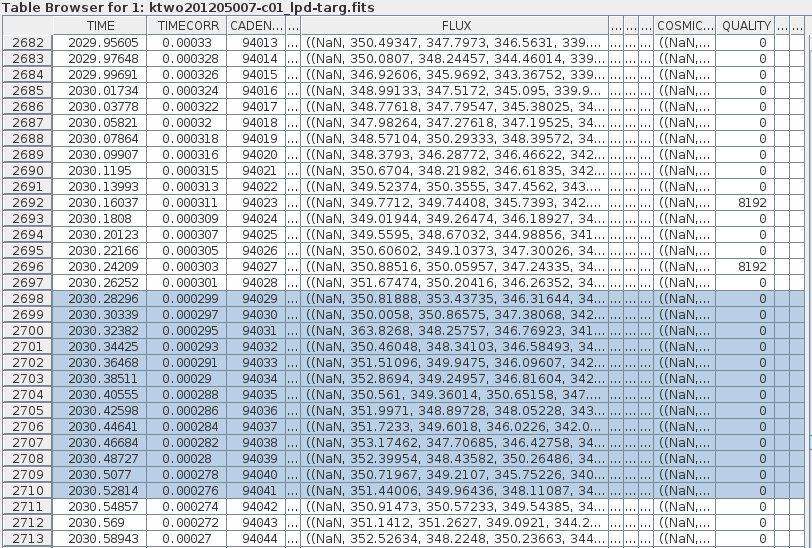KID 201205007 - APHC0120143
-
 by
zoo3hans
by
zoo3hans
KID 201205007 appears to have a single transit at BKJD 2030.35 , as JKD had pointed out in page 4 of http://talk.planethunters.org/#/boards/BPH0000007/discussions/DPH00008nt
Posted
-
 by
zoo3hans
by
zoo3hans
Slightly detrended light curve:

Posted
-
 by
zoo3hans
by
zoo3hans
Zoom into light curve around BKJD 2030.35

larger zoom:

Posted
-
 by
zoo3hans
by
zoo3hans
Transit duration is about 5.5 hours, depth about 0.002 mag. Assuming a 0.5 R_sol star, I would get a 2.5 R_Earth planet with a period around 100 days (very rough estimates only).
Posted
-
 by
ajamyajax
by
ajamyajax
201205007: well my idea here probably a longshot but if a period around 43.7 days works for this star, maybe an earlier transit could be at the 1986.5x BJD glitch area. Looked at the aperture data but saw no sign of it though. However another system with that situation (201577035; see earlier PH comments) had a transit that was basically erased by a glitch and/or correction at this location.
So maybe:
s1=1986.69 p1=43.696 d1=0.25 (6.0 hours or less)
Posted
-
 by
zoo3hans
by
zoo3hans
Dear Mark
an interesting idea. Although in our case here I think there are not enough pixels affected at BKJD 1986.5. I expect 11 pixels and only 6 or 7 could be masked I think. So I prefer a longer period around 100 days or so (depending on the size of the host star which I don't know).

larger zoom:

Posted
-
 by
ajamyajax
in response to zoo3hans's comment.
by
ajamyajax
in response to zoo3hans's comment.
HM: I should have done this earlier, but put together a period estimating routine also. And guess what, I get both our estimates just by changing the AU and the star ratios compared to the Sun. So I suppose to get any further with this one, we need to try to find out more about this star if possible. I looked for a UKIRT or SDSS image but couldn't fine either. There is SkyView data, but only a few stars in the area for any reference help.
Also you are right about the pixel count being less for the glitch area here. But in the other example the glitch area was completely 'corrected' back to normal-looking flux, and for a similar duration of 5.04 hours too. So not sure what is missing here or was corrected, if anything. Maybe it is the primary of a BGEB even. As I mentioned my glitch area transit idea a longshot anyway. But all this still an interesting exercise. 😃
Semi-Major Axis a (A.U.) = 0.356
Stellar diameter ratio = 0.60
Stellar mass ratio = 0.60
Duration ~= 6.00 hours
Period ~= 100.16 daysSemi-Major Axis a (A.U.) = 0.335
Stellar diameter ratio = 0.50
Stellar mass ratio = 0.50
Duration ~= 5.32 hours
Period ~= 100.15 daysSemi-Major Axis a (A.U.) = 0.235
Stellar diameter ratio = 0.90
Stellar mass ratio = 0.90
Duration ~= 5.98 hours
Period ~= 43.86 days





SkyView(s) for EPIC 201205007:


SkyView data:
N | Cat | ID/Name | RA/Lon | Dec/Lat | X | Y
1 | http://archive.stsci.edu/k2/epic/search.php? | 201205007 | 169.2672| -3.9857| 150.0| 150.0
2 | http://archive.stsci.edu/k2/epic/search.php? | 201204931 | 169.2690| -3.9877| 142.2| 141.5
3 | http://archive.stsci.edu/k2/epic/search.php? | 201205574 | 169.2819| -3.9732| 87.2| 203.4
4 | http://archive.stsci.edu/k2/epic/search.php? | 201206102 | 169.2734| -3.9607| 123.6| 257.2
5 | http://archive.stsci.edu/k2/epic/search.php? | 201205750 | 169.2966| -3.9691| 24.3| 221.1
6 | http://archive.stsci.edu/k2/epic/search.php? | 201203850 | 169.2877| -4.0142| 62.3| 27.8
7 | http://archive.stsci.edu/k2/epic/search.php? | 201204224 | 169.2977| -4.0053| 19.5| 65.7Posted
-
 by
Dolorous_Edd
by
Dolorous_Edd
2MASS color - color
H - K = 0.11
J - H = 0.644
J - K = 0.754
Posted
-
 by
ajamyajax
in response to Dolorous Edd's comment.
by
ajamyajax
in response to Dolorous Edd's comment.
Thanks DE. What is your guess as to the size of this star? I tend to think Hans Martin's estimate is closer at 0.5x Sol than my 0.9x guess, but can't back that up with data just yet.
Posted
-
 by
zoo3hans
by
zoo3hans
I'm no expert in this, but it could be a K7V or M0V red dward then. Expected radius about 0.6 R_sol.
See for example http://www.pas.rochester.edu/~emamajek/spt/K7V.txt
Posted
-
 by
Dolorous_Edd
in response to zoo3hans's comment.
by
Dolorous_Edd
in response to zoo3hans's comment.
Agree, looking 2MASS colors I lean towards M0 dwarf too
Now, target listed under GO1059
http://keplerscience.arc.nasa.gov/K2/docs/Campaigns/C1/GO1059_Stello.pdf
further support this
Posted
-
 by
zoo3hans
by
zoo3hans
QUALITY flag of the target_pixel_file:

Posted